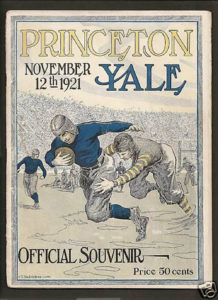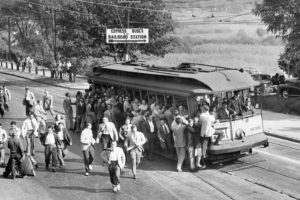 Away to the Football Field
Away to the Football Field
From 1922
Yale Bowl was built in 1913-1914 to accommodate the ever larger crowds that wanted to come out and watch football games. In its time, it was the only known structure of its kind—aside from the Colosseum in Pompeii—in the world. Its walls were constructed from earthen berms faced with concrete; the earth was moved about using shovels, sacks and mules.
Built at an estimated cost of $175,000, it has provided a venue for a broad variety of entertainment over the past hundred years. Here are the recollections of a young girl who grew up near Yale Bowl in its earliest days:
By Loretta Bontempo Forte
Autumn in Allingtown, especially at our home on Derby Avenue, meant three things: the back-to -(Forest) school routine, the harvest and canning of our garden yield, and FOOTBALL, and especially, Ivy League Football, because our house bordered the Yale athletic fields, and Yale Bowl.
In school, our fourth grade music lesson lasted most of the afternoon, and included seasonal songs.
In the fall, our favorite rousing song was one we already knew, having heard the older children sing this traditional song every autumn:
Our men are ready, their best to do, and never an inch will they yield…. Hurray for some fun, now school is done, away to the football field!(Sung to the tune of “Over the river and through the woods…)
Our teacher, Miss Cook would beat a ruler in time to the music and we would all sing at the top of our voices.
My memories of football were inspired by that song and living near Yale Bowl, which we could see from many windows of our home. But my memories are not of the players and the scores, but of the fans. Traffic started on Derby Avenue and the adjacent streets early in the day on Yale football Saturdays.
Every available plot of land in our neighborhood was used for parking cars. YALE Bowl held 80,000 fans at that time and most of the time, the stadium was filled to capacity. The fans would park blocks away and walk in a colorful procession from all directions to the field.
The fans included young and old, men in fine camel haired coats, women in raccoon coats, with clothing and accessories of the college’s team colors. Banners and pennants of blue for Yale, feathers dyed to match in a variety of Ivy League colors; blue for Yale, red for Harvard, orange for Princeton, those were the colors of the passing procession up and down Derby Ave. Army and Navy played there back then, so the stars and stripes were prevalent at every game, but especially then.
Our family parked cars in our yard, too. For the big games, you could charge a dollar a car, my father quipped that football parking paid his taxes for the year. We attracted some celebrities, and their chauffeurs would remain in our yard with the fancy cars. They would tell pleasant, glamorous tales of the prominent owners. They would tell of the special events to which they drove, and the famous names of those who rode with them. Their names could be found in the New York Times society, sport, or business pages. We got to recognize the celebrities by sight and we had returning cars each season as the friends met in our yard to tail gate.
I still remember the prominent names but we children were pledged to secrecy as to who came and returned seasonally to park and enjoy their private tailgating parties pre-game.
My biggest thrill was to be called to our front porch and invited to lunch with our former CT governor and his wife. I declined with timid thanks but continued to watch from inside.
A Rolls-Royce returned each year to park on our cement ground level patio. All of our returning customers and some new, special patrons would get their special spots, and one chauffeur required a secluded spot with right-of-way for his Isotta Fraschini, an Italian motorcar that I saw only once ever.
 Open trolley cars came from downtown New Haven and left fans off at Yale field, for tail-gating and the game, and remained parked all along the avenue during the game…as they arrived we could see that every bench in the trolleys was filled, people were hanging off the running boards and the motor men were merrily clanging the bells to add to the festive atmosphere.
Open trolley cars came from downtown New Haven and left fans off at Yale field, for tail-gating and the game, and remained parked all along the avenue during the game…as they arrived we could see that every bench in the trolleys was filled, people were hanging off the running boards and the motor men were merrily clanging the bells to add to the festive atmosphere.
When I was older I got to go to the games and sing Boola Boola myself, but it was not as glamorous as actually being among the celebrities and fancy cars. Hearing about Albie Booth and hearing the cheering from afar was what made the rah-rah days of football season special in my old neighborhood on Derby Avenue.